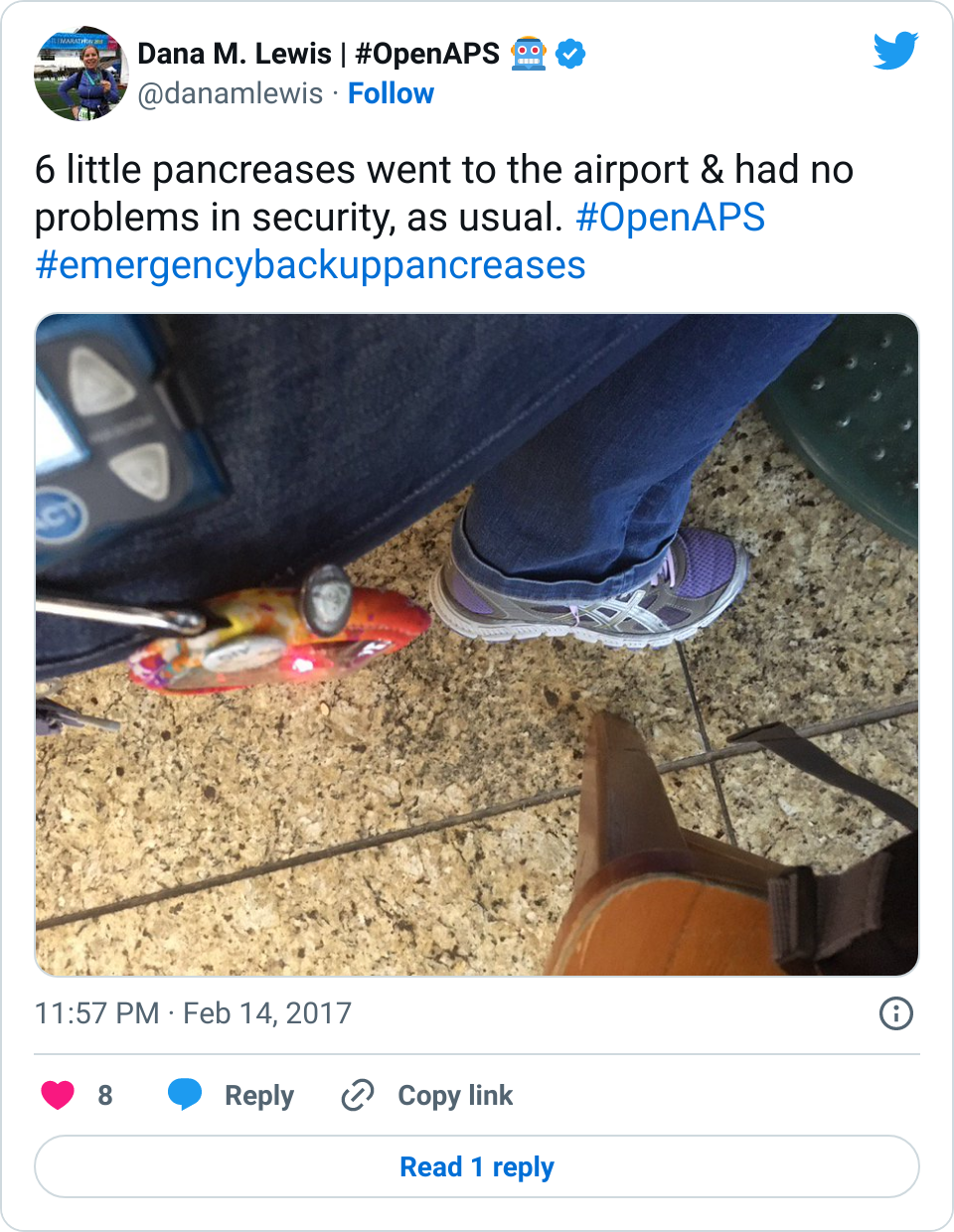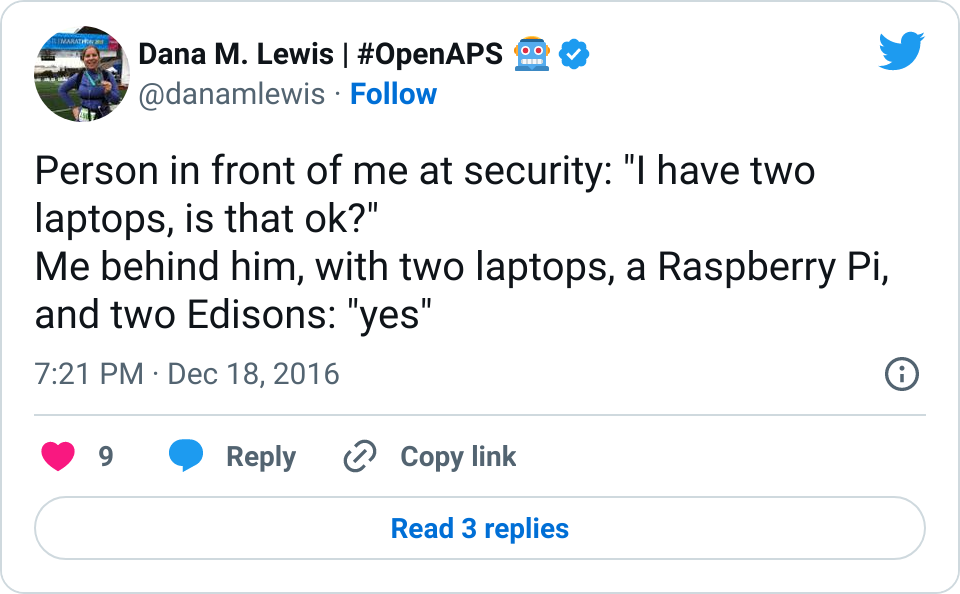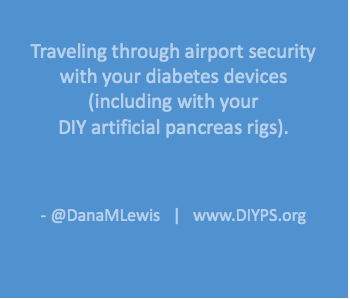tl;dr: Put your #OpenAPS or other artificial pancreas rigs through the x-ray machine; it’s a small computer and a battery.
I travel quite a bit these days, so it’s pretty routine for me to pack up my diabetes gear and backup supplies and whisk away to the airport and the next adventure. In fact, in 2016 I think I went through airport security 44+ times, in several countries. I have never had any issues with my #OpenAPS (DIY hybrid closed loop artificial pancreas) rigs – even when I carry multiples. Here are some tips on what gear should be put where, who should be told what during the security process, and how to further simplify (as much as is possible with diabetes!) the airport security experience when traveling with diabetes.

A list of diabetes gear you’re probably packing for your trip:
- BG meter
- Test strips
- Lancet(s)
- Pump sites
- Reservoirs
- CGM sensors
- CGM receiver
- Tape for sites/sensors
- Syringes as back up
- Anti-nausea meds
- Depending on the length of your trip, backup pump/transmitter/meter/receiver/etc.
- Snacks
- Extra batteries to power your phone for uploading BGs
- (Uploader phone if you’re still using an uploader to Nightscout)
- Artificial pancreas rig (i.e. #OpenAPS rig, whether that’s a Raspberry Pi or Explorer Board setup, or a Rileylink)
- Insulin
- Extra insulin
- Juice for lows
Out of that list? Here are the only things I would pull out of your bag.
- Insulin/extra insulin*
- Juice for lows**
Everything else (yes, including your CGM receiver; yes, including your pancreas rigs) can stay in your bag and go through the x-ray.
*If you have a single bottle of insulin, it’s under the liquid (3oz) limits, so you don’t technically need to pull it out. But if you are carrying numerous bottles/pens/etc., if you have them separately bagged and can pull out separately, I would do so in order to reduce the risk of them flagging your bag for needing additional screening.
** Yes, you have a medical need for liquid and can take juice through security. HOWEVER, I *highly* recommend having this in a baggie and pulled out of your bag so it is separate. They’ll often pick that up, examine it, and if you say “medical liquid for diabetes”, it’s fine. Sometimes you’ll get pulled for a pat down, but not always. And, this usually prevents them from having to dig through your bags to find the juice and go through all your things. (Which is annoying, not to mention time consuming).
My second “HOWEVER” related to juice: I’ve stopped carrying juice for lows when I air travel. Yes, it only takes an extra couple of minutes or whatever for them to check things out, but I’d rather not have any hassle if I can avoid it. I instead have switched to Starbursts, Skittles, and similar. (They’re super fast acting for me, and actually make it easier to do a small 4g correction vs having to bust open an entire 15g juice box that can’t really be saved for later.) I have those in my pocket or easily accessible in an outer pocket of the bag that will go under my seat on the plane. You can of course still carry juice, but think about if that’s really worth the hassle/effort and if there’s an alternative (glucose tabs, small wrapped candies, etc.) that might be easier for treating lows when traveling. YDMV, of course.
(My favorite carrying-juice-through-security story is this: I was traveling to somewhere in Europe while in college (well before my DIY closed loop days), and I had a large baggie jam-packed with 8 or 9 juice boxes and a bottle of insulin. Despite telling them that I had diabetes and was traveling internationally and this was medically necessary in case of low BGs, the TSA agent said “how many juice boxes could you possibly need in an 11 hour flight? You wouldn’t use more than one, right?” It was *really* hard not to laugh.)
What about insulin pumps? Do you take it off?
- I currently am wearing an insulin pump that does not alarm in 99% of metal detectors because it’s not made with lots of metal. I also have TSA Pre-Check, which means 95% of the time when traveling in the U.S. I am only asked to go through a metal detector. So right before I walk up to security, I take my pump that’s usually clipped to an outer pants pocket and clip it inside my waist band and underneath my shirt. If it doesn’t alarm, then I proceed like a usual traveler to get my bags and be on my way.
- If I am randomly selected by the metal detector to instead go through the body scanner:
- YDMV/YMMV, but there are no guarantees that the body scanners will not break your pump. And if you have a super special limited edition rare pump that does a special thing (like those that enable you to DIY closed loop), as I do, it may make you decide that a pat down is better than risking your pump, since if it DOES break due to scanner interference, TSA sure isn’t going to pay to fix it/get you a new one, and a new one wouldn’t allow you to DIY closed loop anyway.
- So, if I get randomly selected, I stop right there and say “opt out”. Say it to whoever is pointing you over to the body scanner, they’ll posssibly read you a script to confirm you want to opt out, and just keep saying “yes, I opt out” and “that’s fine” to the “but then you have to have a pat down!”. They’ll order up a same-gender TSA agent who will come get you, escort you around the body scanners, and you’ll get your pat down. The usual applies – if you want, you can ask for a private area for your pat down. I usually don’t care, but if you do, make sure you keep an eye on your bags and ask for those to come with you so they’re not left out in the open for anyone to accidentally take. (They’re usually pretty good about that, though.)
- For the pat down, they’ll ask you about sensitive areas/medical devices. This is the time to point out your pump; tell them (pat the area) where it’s connected, and ditto for patting/pointing out your CGM sensor if you have one. They’ll be extra careful then to not accidentally catch their hands on those areas.
- At the end, they’ll go swab their gloves, then come back and ask you to pat/touch your pump and then let them swab your hands.
- If you don’t have Pre-Check, the above will likely happen every time. So if you’re an opt-out-of-body-scanner-type and travel more than 2 times a year…IMO Pre-Check is worth the money. (And think about getting Global Entry, which comes with Pre-Check included, and also gets you expedited return to the country after traveling abroad).
- If you have a metal-cased pump (or any other pump, and just want this instead of the metal detector or the body scanner), you can ask for a hand inspection of your pump. Different manufacturers say different things about whether x-ray and body scanners are ok/not ok, so check with them and also go with your gut about what you’d like to do with your pump. Keep in mind that the radiation your carry-on luggage gets from the hand-luggage x-ray is about 100 times what your body gets from a backscatter x-ray, so if you’re concerned about x-ray radiation damaging your pump, it should not be sent through the scanner with your carry-on luggage.
What about a doctor’s note?
I have never carried a doctor’s note, and have not had an issue in the 14+ years I’ve been flying with diabetes – including in dozen of international airports. YDMV, and if you’d feel more comfortable with one, you can get one from your doctor. But for what it’s worth, I don’t travel with one.
What about international airports?
The only thing to know about international airports is they have similar guidelines about liquids, so plan to also pull out your juice and toiletries from your bag. Same rules apply for keeping rigs, supplies, etc. in your bag otherwise. I’ve never had an issue based on pancreas rigs internationally, either. They’re small computers and batteries, so both TSA and international security are used to seeing those in the x-ray.

(Let me know what other travel-related questions you have, and I’ll keep adding to this post if it’s helpful. Happy traveling!)

Great post! We have yet to fly with OpenAPS, but we’ve flown quite a bit domestically and internationally with T1D. Our experience has led us to always travel with a letter from our doctor. While we might not need it, we have a letter just in case. In fact, not only have we been asked for documentation, but in Germany, we were even given a hard time because it was in English. (Good thing we speak German!) And a reminder to folks, not all regulations/laws in the U.S. are the same in other countries. Years ago, we used to take yogurt for moderate lows. In Ireland, we were forced to throw it out, and also forced to send our backup pump through the x-ray scanner.
On a different, but related point, I’d love to hear if you’ve experienced some of the problems we’ve discovered with flying. We had read a post years back (https://asweetlife.org/what-you-should-know-about-flying-with-an-insulin-pump/) and performed our own little experience on our last trip to Europe. We had an alarming discovery – a lot of insulin was delivered through takeoff and a big air bubble developed upon landing. This explained our previously experienced lows mid-flight to Europe and our extraordinary highs two hours after landing. I think we’ll probably still disconnect for flights, but anticipate OpenAPS helping a lot more.
Thank you for this! I’m well versed in traveling with diabetes, but not so with my diy set up so I really appreciate having this resource.
What is Pre-check! I have a insulin pump and going to Germany In September . Do I need this Pre-check?
Pre-Check is a program used in the US for faster security lines. You don’t have to get it, but it is handy (and often means shorter security line, too). (More details on it here: https://www.tsa.gov/precheck). If you don’t have Pre-Check, you’ll end up in a security line with a body scanner and can choose to go through it; or ask for a hand-check of your pump and pat down instead.
Thanks for the post, we are traveling international this year for the first time in many and I have had some difficulty with tsa locally with my pump so your info is going to be helpful.
I just disconnect my pump and Dexcom receiver and ask for a hand check. It is usually done before I get through the scanner. Works for me
This! I want to do this. Every time I’ve asked, they said they can’t… why? I’m bringing a ziploc for this next time. Thank you!! I’m just going to ask for a hand check of my pump(s) (including backup) and I’ll just go through the scanner. I’ve never been!